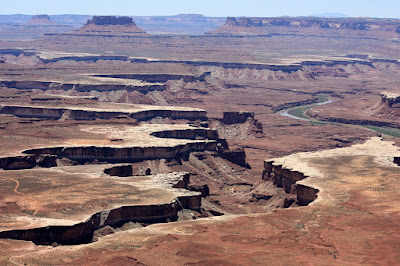Canyonlands is situated about 30 miles due west of Arches so getting to our next Park was a breeze. Like Arches, this area began its development 300 million years ago. This high desert landscape is the work of the convergence of two rivers - the Colorado which created the canyons to the northeast and the Green River which carved its way thru Canyonlands from the northwest. The two rivers converge in the middle of the Park thus dividing it into three distinct "districts". The Island in the Sky, The Needles and the Maze.
We entered the Park from the north into the Island of the Sky district. From the Island perspective, you can see the workings of both the Colorado and Green Rivers. Pictured above is the Green River and the White Rim of the canyons above.
What fascinated me about this park is its expanse. From our Rim Walk Hike, we could see what appears to be an impassible hundred mile stretch of a deep canyon carved out of sandstone by the two rivers. How the heck did the Pioneers ever get across this landscape in covered wagons?
They had no paved highways like the one that allowed us easy access to this barren land. How the heck did they cross the rivers? They did not have the luxury of bridges as we do today. As I looked down upon the canyons below I couldn't help but think about what a rugged life it must have been to be one of the early pioneers heading west. So many obstacles in the way. Canyons, rivers, mountains, desert...not to mention the locals who really didn't want paleface invading their sacred lands. It's a wonder that any of the early Pioneers survived the trek west. Makes me feel like our Trek is a walk in the Park! (which it is!) Thank you Pioneers for paving the way for us youngin's!
Mesa Arch
Mesa Arch is located in the Island of the Sky district about 6 miles south of the Visitor's Center. The hike to the Arch is an easy loop of about a half mile that treats you to a variety of flora and a few fauna's.
Like its neighbor, Arches National Park, Canyonlands hosts a wide variety of geological formations. Although not nearly as plentiful as those in Arches, Canyonlands is home for many arches, fins, spires, "needles", mesas and more.
The one thing it really lacks, however, is a decent campground. We checked out the modest campsites and opted out. No shade, no water, Pit style potty...no bueno! Adios Canyonlands!
Mixed in amongst the Mormon Tea, Pinion Pines and Utah Juniper, we found colorful blooms of the Prickly Pear...a reminder that even at 6000' we are still trekking about a high desert climate.
The view at the end of our Rim Walk Hike treats you to Junction Butte and the wide expanse of this colorful canyon. The irony of this area is that water is the primary carving knife yet the area is a climatic desert receiving less than 15 inches of rainfall annually.
The Shafer Trail access road leads down to the White Rim Road. Notice the many different layers of sandstone on the canyon walls. Some layers are smooth while others are brittle and rough. The colors along the cliffs are a visual delight! Depending upon which millennium the sands of time were deposited on the floor of the ancient seas, the pigments will vary between a light tan turning toward a mocha mixed in with a deep rich red sandstone.
Mix in the sunshine and this region comes alive with a sedimentary explosion of color.
One of the more exhilarating ways to experience Canyonlands is via 4 wheel drive vehicle. Point the hood down the very steep Shafer Trail access road (shown in the previous picture) and head out on the 100-mile long White Rim Road.
"The Dirt's alive!"
That knobby black and brown soil at the top of the picture is a complex living organism known as biological soil crust! "Step on the crust and you kill it!" cry out the Rangers. This BioCrust is made up of cyanobacteria, lichen, algae, fungus and moss and its job is to retain moisture, prevent erosion and add nitrogen to the soil so that other plant material in the area can thrive.
The end of our Trek thru Canyonlands...next up, we exit the high desert and head for the hills - Rocky Mountain National Park.













No comments:
Post a Comment